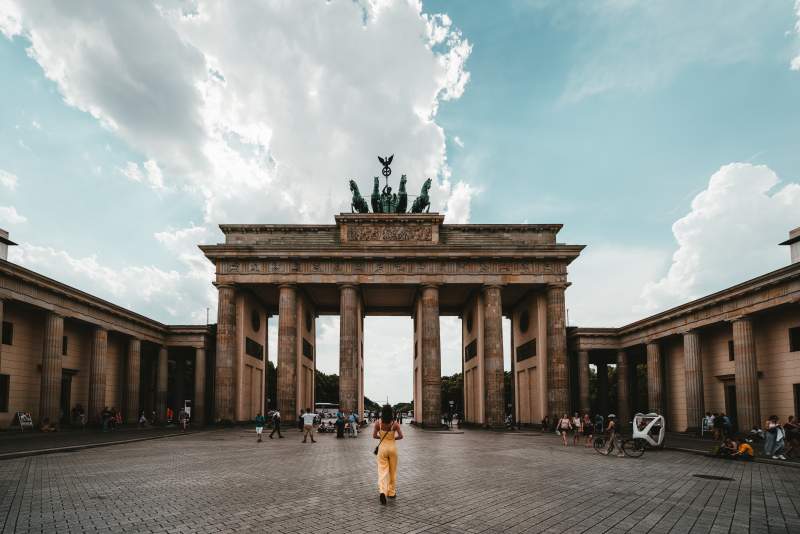Have you ever wondered what the easiest languages to learn are?
As we enter the new decade, maybe you’ve decided it’s the perfect time to attempt one of your long-term goals and try to learn a foreign language.
Except you don’t want to be too ambitious. You’d prefer to start learning something that gives you a reasonable chance of success.
(Although if you're using the StoryLearning method, you can make a success of any language!)
If that sounds like something you’ve been mulling over, or even if you’re just curious, here’s my list of the easiest languages to learn – for English speakers.
Oh and stick with me till the end to find out how to make learning any language “easy”, even the so-called hardest ones.
If you're in a hurry, discover the 5 easiest languages to learn in the video below. Otherwise keep reading to discover all 13 languages.
#1 French

While anyone who has struggled with masculine and feminine or verb conjugations in French might disagree, this is a very easy language for English speakers to learn. And for one important reason – vocabulary.
For nearly 1,000 years, French has heavily influenced the English language. And it’s estimated that almost a third of English vocabulary comes from French, giving you a huge head start when you begin learning it.
English is now also sending plenty of words back the other way – “sandwich” and “weekend” are just two examples. So with this much shared vocabulary, learning French is about as simple as it gets.
Want to make your French learning journey as simple and smooth as possible? Check out French Uncovered, my beginner French course that will get you to intermediate level in the language through the power of story.
#2 Spanish

Spanish is a close relative of French. And although it shares fewer cognates with English (a fancy way of saying ‘words that are the same’), there are some other features that make it super-easy.
Spanish is simple to pronounce for English speakers. And it is extremely phonetic. So the way it’s written is the way it’s said.
Basic grammar is no problem, either. Although it does become a little more complicated at higher levels.
Since it’s so popular, there are plenty of resources to help you learn. And as one of the world’s most widely spoken languages, you shouldn’t have trouble finding native speakers to practise with.
If you're ready to get started with Spanish, then I recommend Spanish Uncovered, which teaches you Spanish through a fun and natural method that makes learning a pleasure, and grammar a breeze!
#3 Italian

Like French and Spanish, Italian belongs to the Romance family of languages. And it’s one of the easiest languages to learn for many of the same reasons.
There are very few unfamiliar sounds – the gli sound is probably the hardest – and it’s also written phonetically. So there are few traps once you know the rules.
If anything, Italian tenses are less complicated than in Spanish. And there’s not much other grammar that will cause you any bother. It’s also another very popular language, so there are plenty of resources to help you learn it.
Taken together, all this makes Italian another of the easiest languages for English speakers to learn.
So easy in fact, that I learned Italian in London in 3 months by consuming compelling content like blog posts, podcasts and books. And you can copy the method I used in Italian Uncovered, my course for beginner Italian learners where you learn though story.
Check out my Italian speaking skills after three months in the video below:
#4 Portuguese

Portuguese is the last of the ‘Big Four’ Romance languages. And like the others, it’s easy for English speakers to learn.
Written Portuguese looks similar to Spanish. But when you hear it, some say European Portuguese sounds more like Russian. However, the sounds are not particularly hard to master. And the grammar is no more difficult than in Spanish or Italian.
The difference between Brazilian and European Portuguese might be a sticking point since the two have diverged significantly. But as an important world language, there’s plenty of learning material. And it should be easy to find native speakers to practise with.
Struggling to choose between Spanish and Portuguese? I've put together this guide to help you pick the right language for you. And if you decide to go with Portuguese, hop on the waiting list for my new Portuguese course.
#5 Romanian

Romanian is closely related to French, Spanish, Italian and Portuguese. And like its sister languages, it’s not hard to master. It might seem superficially unfamiliar. But once you start studying it, you will soon see how similar to the others it really is.
Even if you know just a little of one of the others, you will quickly notice the parallels. To give just one example, “bread” in French, Spanish and Italian is pain, pan, and pane – and in Romanian, it’s pâine. Different, yes, but not so much.
Admittedly, if Romanian is your first foreign language, it might seem quite alien and exotic. But even if that’s the case, it’s objectively much easier than the languages of the countries surrounding Romania, which are counted among the most challenging in Europe.
#6 Dutch

Dutch and English belong to the West Germanic language family and are close cousins.
The two have much vocabulary in common. And since they share such ancient roots, the common words also tend to be some of the most basic – groen (green) and oud (old) for example.
Dutch grammar has gender, although it doesn’t affect sentences as much as in French. However, unlike German, it doesn’t have cases, making it an easier proposition.
There are one or two sounds that might need work. But word stress is similar to English. So on the whole, for English speakers, pronunciation is fairly intuitive.
This all means that, although you might not guess it, Dutch is among the very easiest languages for English speakers to learn.
The biggest struggle you’re likely to have with Dutch is that most Dutch people speak English. But they also like it when you speak Dutch because it’s not a very common language for foreigners to learn. So even more reason to give it a try!
By the way, my short story collection for beginners now also exists in Dutch. Click here to find out more.

#7 German

As another of the West Germanic languages, German is closely related to English – although not as closely as Dutch.
German is notorious for its tough grammar. And with three genders, four cases and some odd syntax, there’s no doubt it’s a tricky one to tackle.
However, there’s also a lot about German that makes it easy for English speakers. German and English share many cognates (for example, Mann and man). Or words that are easy enough to guess, like Stuhl (chair) Hund (dog).
Verb forms are not so hard. And German pronunciation is also relatively easy for English speakers. As one of Europe’s most important languages, it’s one that’s well worth the effort of learning.
And of course, if you want to learn German from scratch, without stressing over grammar, then German Uncovered will help you to learn to speak German through the power of story.
#8 Swedish

Swedish belongs to the North Germanic language family. So it’s more distant from English than Dutch or German. But it’s still quite close.
It has the same subject-verb-object sentence structure as English. And verbs don’t change much, making it easier than Romance languages in that respect. There are also lots of words that are similar enough to guess. So the vocab isn’t too bad, either.
Pronunciation is a special challenge in Swedish since it’s a ‘pitch-accent’ language. Words can have different meanings depending on the intonation, making Swedish about the closest thing in Europe to a tonal language.
Although it’s nowhere near as tough as true tonal languages like Chinese or Vietnamese.
Other than this, there are few major obstacles, making it perhaps the easiest of the Scandinavian languages to learn. Check out “Short stories in Swedish” to start learning Swedish through story.
#9 Danish

Danish is very close to Swedish, with similar vocabulary and grammar. And is another language that’s easy for speakers of English.
The main difficulty is connecting the writing to the spoken word because, at first glance, there seems to be little relationship between the two. However, this problem disappears with practice. And once you’ve nailed the way it’s written, you shouldn’t encounter many other major hurdles.
So Danish could be a possibility if you’re looking for a moderate challenge but nothing too taxing. And you can learn Danish by reading with my short story collection for beginners.
#10 Norwegian
Norwegian is similar to Swedish and Danish, although it’s arguably the trickiest of the three. One problem comes from the fact that there are actually two Norwegian languages to learn, written Norwegian (Bokmål) and New Norwegian (Nynorsk).
Like Swedish, it’s also a pitch-accent language, although not quite to the same extent. And for beginners, the pronunciation might not always be immediately obvious from the spelling either. But one very cool reason to learn Norwegian is this language has so many dialects and accents that you can get away with your own weird one!
As I said, there two written forms of the language, but no standard spoken form, which makes pronunciation NOT super strict. Hey, if you look the part and know a few good sentences, you can just say you’re from a different part of the country!
However, as with the other Scandinavian languages, the difficulties are far from insurmountable. And once you become used to the idiosyncrasies of Norwegian, you’ll find it another extremely easy language to pick up.
And Norwegians will even help you with that. In most Norwegian towns and cities, you'll find Språkkafe (language cafes). If you’re a traveler, you can hang out in a language café, just to practice speaking and listening in Norwegian.
They’re usually run by Norwegians who’d love to help you learn. So you’ll probably make some friends, adventure buddies and language partners, all in one go! Otherwise, you can immersion yourself in Norwegian from home with my short story book.
#11 Indonesian

Probably the easiest Asian language to learn, Indonesian is written in the Latin script, is completely phonetic, has no tones and has no difficult sounds to pronounce either. Yes, you read that right.
The grammar is endearingly simple. For example, words don’t change for plurals. And you can just repeat a noun to indicate more than one: anak is “child” but anak anak means “children”.
There are no tenses, and where necessary, time is expressed with time markers. “I eat” is saya makan, and you just add sudah (already) for the past: saya sudah makan (literally, “I already eat”).
If there’s one complication, it’s Indonesian affixes. For example, makan means “to eat”, but adding the suffix –an makes it a noun, so makanan is ‘food’. But this also helps build your vocabulary very quickly.
There are also several loan words from English and Dutch – like sekolah (school) – making it even easier.
So, if you want to learn something exotic but aren’t ready for anything as hard as Chinese or Thai, Indonesian could be the one to go for. And with around 200,000,000 speakers, it’s pretty useful too.
#12 Afrikaans

The language of Charlize Theron and Trevor Noah, well, one of Trevor’s languages anyway! Imagine making fun of politicians with Trevor in Afrikaans… that would be a laugh!
Now Afrikaans is one of the easiest languages for English speakers to learn, and a must if you plan to visit South Africa, or any of these cool countries:
- Namibia
- Botswana
- Zimbabwe
- Mozambique
You might have heard that Afrikaans is related to Dutch. It is, but they’re by no means identical twins! Afrikaans is its own language – and a lot easier to pick up than Dutch.
For one, there’s no grammatical gender. So just like we say “the” in English to talk about both singular and plural things, Afrikaans also has only one word: “die” (a lot easier than other Germanic languages, like German, where you have to choose between two or three versions of “the”.)
Then, verb conjugation is almost non-existent. And there are only three tenses! So there’s no need to differentiate between different past tenses.
For example:
- “I sang” and “I had sung” is just one word in Afrikaans – gesing.
Same thing in the present tense:
- “I walk” and “I am walking” are one phrase in Afrikaans – ek loop.
Music to the ears of anyone who’s struggled with verbs in French or Spanish.
But enough of grammar. Let’s check out the fun part: the words! Did you know Afrikaans has some really cool vocabulary? Yeah, it’s a highly descriptive language.
- Take tuinslang (hose pipe), which literally means “garden snake”
- And then verkleurmannetjie (chameleon) literally means “colour-changing little man”
- And cameelperd (giraffe) is a “camel horse”
I mean come on words like this, you just can’t forget!
You may be surprised to hear that Afrikaans also borrowed from Malay, Portuguese and Bantu languages. But it shares many root words with English making the spelling rather intuitive. So don’t be surprised if you can read it before you can speak it!
So how does all of this help you as a language learner?
Well, let’s see…
You’ve got logical sentence structure, no inflection, and memorable words which means it’s possible to build up your own sentences even with little vocabulary, putting it right up there with easiest languages to learn.
Although you will need to watch out for some tricky pronunciation:
- Like the “G”, which sounds like the CH in “Bach”
- They also roll their R’s… which is always a pet hate for English speakers!
#13 Honourable Mention: Esperanto
There’s one language I haven’t included in my list that deserves an honourable mention – Esperanto.
If you don’t know about Esperanto, it’s an ‘artificial’ language that was created specifically to be as easy to learn as possible.
This means it doesn’t have any of the features found in ‘real’ languages – gender, case, irregular verbs, tricky pronunciation and so on – that most people find difficult.
In theory, then, Esperanto should be the easiest language to learn of them all!
So What Is The Easiest Language To Learn?

The truth is, there is no simple answer to the question of which language is easiest to learn since it is so subjective. Some people are naturally better at grammar while others have a talent for pronunciation – it depends on you as a learner!
I also stated at the beginning that this is a list of easy languages for speakers of English.
However, for speakers of Chinese or Russian, for example, the list would be completely different because proximity to your native language also has a significant effect on how easy any language is for you to learn.
That said, I'll finish by repeating something I often tell people – all languages are easy if you practise every day.
But even the languages on this list will be a big challenge to learn if you only study once a week.
However, if you want to try learning a language that won’t tie your brain in knots, any of the languages on this list would be a great place to start.

Olly Richards
Creator of the StoryLearning® Method
Olly Richards is a renowned polyglot and language learning expert with over 15 years of experience teaching millions through his innovative StoryLearning® method. He is the creator of StoryLearning, one of the world's largest language learning blogs with 500,000+ monthly readers.
Olly has authored 30+ language learning books and courses, including the bestselling "Short Stories" series published by Teach Yourself.
When not developing new teaching methods, Richards practices what he preaches—he speaks 8 languages fluently and continues learning new ones through his own methodology.











































